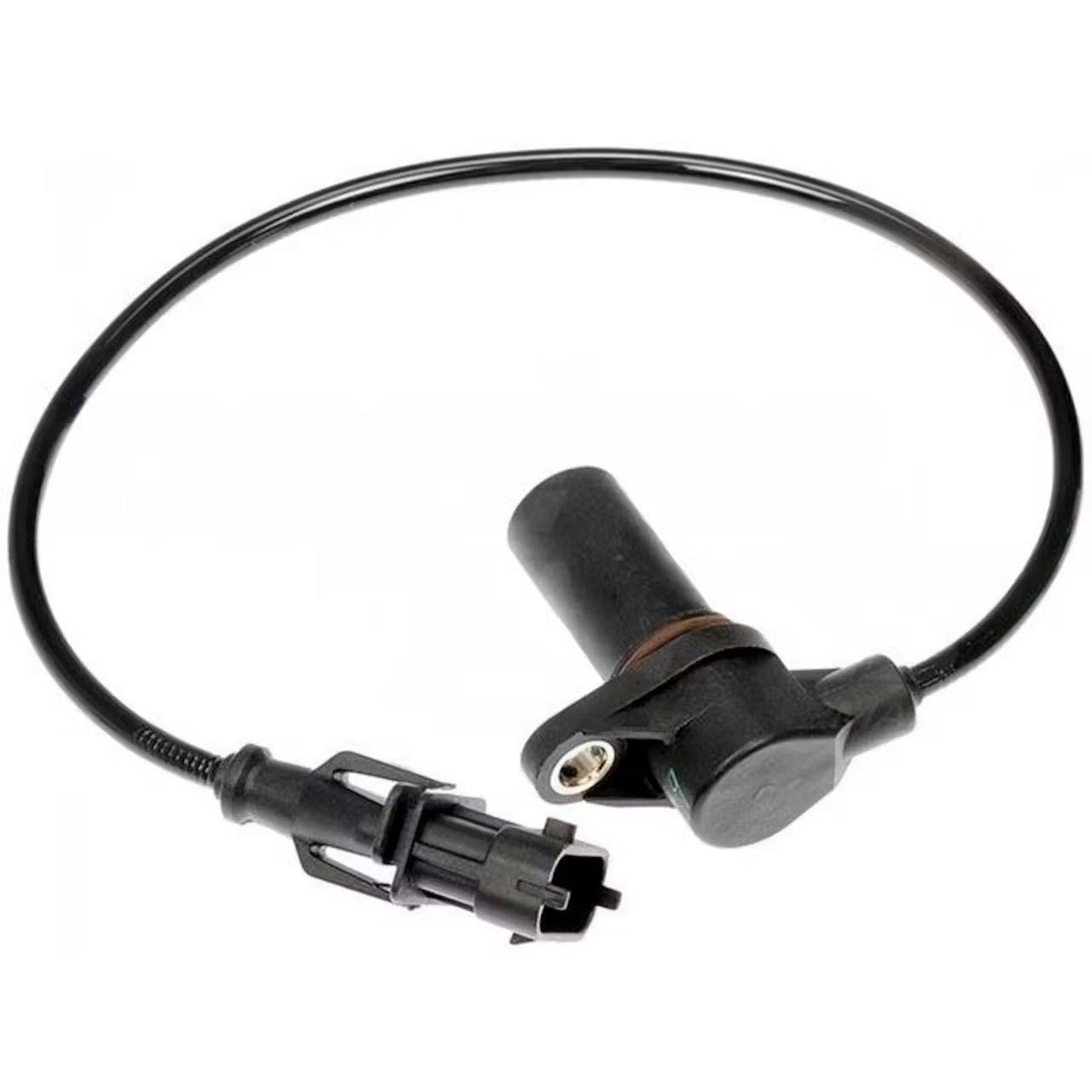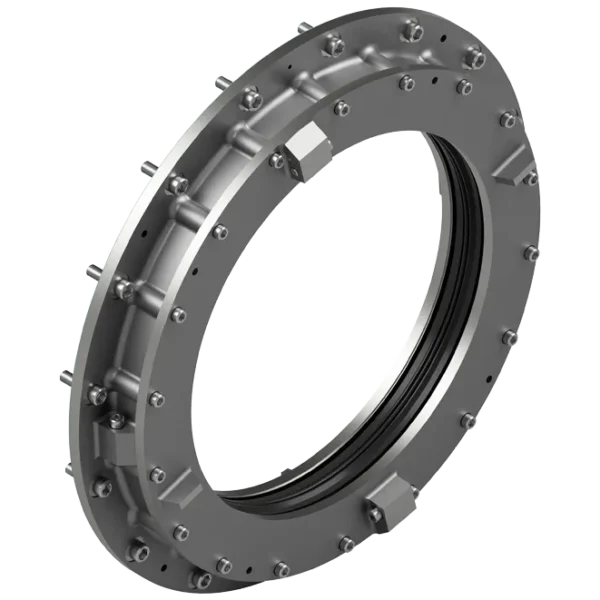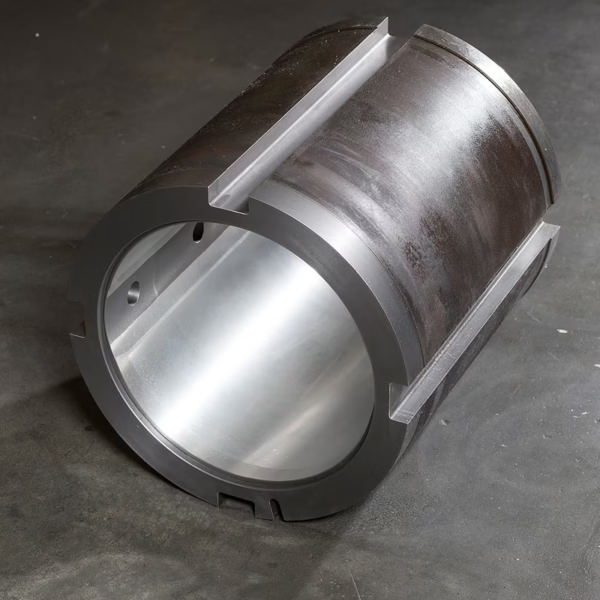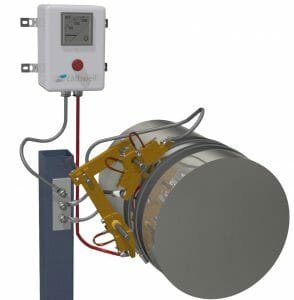A marine crankshaft speed sensor, also known as a crankshaft position sensor (CKP), is a key component of an engine’s electronic management system.1 Its function is to monitor the rotational speed and precise position of the crankshaft.2 It provides this vital information to the Engine Control Unit (ECU), allowing for the accurate timing of fuel injection and ignition.3
Working Principle
These sensors are a non-contact type, meaning they do not physically touch the crankshaft.4 They are typically mounted near a toothed wheel or “reluctor ring” on the crankshaft or flywheel.5 As the crankshaft rotates, the passing teeth interrupt a magnetic field generated by the sensor, producing an electrical signal.6
There are two main types of sensors used:
- Inductive (Passive) Sensors: These sensors consist of a magnet and a coil of wire.7 When a metal tooth on the reluctor ring passes, it creates a change in the magnetic field, inducing a small AC voltage in the coil.8 The frequency and voltage of this signal are used by the ECU to calculate engine speed. They are simple, durable, and highly reliable.
- Hall Effect (Active) Sensors: These are more modern and precise. They use a Hall element that generates a digital square wave signal when a magnetic field changes.9 This provides a more consistent signal regardless of engine speed, making them better for low-RPM readings and more advanced engine control.10 They typically require a power source.11
Importance for Engine Management
The data from the crankshaft speed sensor is fundamental for the operation of a modern electronic engine.12
- Fuel Injection Timing: The ECU uses the crankshaft position to determine the precise moment to inject fuel into each cylinder for optimal combustion and efficiency.13
- Engine Speed Monitoring: It provides the data for the tachometer on the bridge or in the engine control room, and it is used by safety systems to trigger alarms or shut down the engine in the event of an overspeed.
- Diagnostic Information: A faulty sensor will cause the ECU to store a trouble code, helping engineers diagnose problems.14
Common Maintenance and Issues
While reliable, crankshaft sensors can fail, leading to significant engine problems.15
- Failure Symptoms: A failing sensor can cause difficulty starting, rough idling, misfires, or the engine may suddenly stop.16 In some cases, the engine may start when cold but fail when warm.
- Causes of Failure: Failure can be due to mechanical damage, wiring issues (short circuits or breaks), contamination from metal debris, or a misadjusted air gap between the sensor and the reluctor ring.17
Spares and Manufacturers
- Spares: A spare crankshaft speed sensor is a critical item for a vessel’s inventory. Because the sensor is a sealed unit, the only spare part is the sensor itself, along with any O-rings, mounting bolts, or shims required for correct installation.
- Manufacturers: The market includes both the original engine manufacturers (such as Yanmar, Caterpillar, and MAN) and specialist sensor companies like Bosch, Hella, Denso, and Continental, who supply components to the marine industry.
A functional crankshaft speed sensor is a small but vital piece of technology that ensures the efficient, safe, and reliable performance of a modern marine engine.
We offer an extensive range of marine engine brands and their associated spare parts, providing comprehensive solutions for both main propulsion and auxiliary power needs across diverse vessel types. Our supply capability covers various generations and models, ensuring support for a wide array of marine applications.
Featured Brands and Engine Series/Models:
SULZER:
- Two-Stroke Engines:
- RD/RND Series: RD68, RND76, RND76M, RND90, RND90M (Classic large-bore, low-speed engines, still in operation).
- RLA/RLB Series: RLA(B)56, RLA(B)66, RLA(B)76, RLB90 (Developed two-stroke designs).
- RTA/RT-Flex Series: RTA38, RTA48(T), RTA52, RTA58, RTA62, RTA72, RTA76, RTA84, RTA84M, RTA84C, RTA96 (Modern, fuel-efficient, electronically controlled two-stroke engines).
- Four-Stroke Engines:
- Z Series: ZL40/48, 16ZAV40S (Medium-speed engines).
- RF Series: RF44, RF56 (Often used for auxiliary power or generator sets).
- TAD Series: TAD36, TAD48 (For specific applications).
MAN (including pre and post-MAN B&W models):
- Two-Stroke Engines (KZ, KSZ, K, L, S, MC/MC-C, ME/ME-C): 40/54A, 52/90N, 57/80C, KZ57/80F, KSZ70/125, KSZ78/155, 90/160A, 52/55L, 58/64, 90/190C, L60/105E, 70/120E, 70/125C, L, KSZ78/155A, KSZ70/125B, L52/55A, 40/45 (A broad spectrum covering main propulsion and auxiliary engines).
B&W (Burmeister & Wain – prior to MAN B&W merger):
- MC/MCE Series: L35MC, L60MC, L80MC, L55GFCA, L80GFCA, L80GB, 74VT2BF, K62EF, K74EF, K84EF, K45GFC, K67GFK, K80GFK, K90GFS, 45HU, L70MC (Various generations of two-stroke diesel engines).
- MC-C/ME-C Series: L50MC, S60MC, S70MC, K80MC, S80MC, K90MC-C, L67GFCA, L90GB (Electronically controlled and conventional two-stroke engines).
- VT2BF/EF Series: 50VT2BF, 62VT2BF, K84EF (Older models still in service).
MITSUBISHI:
- UEC/UET Series: UEC37L/LA/LS, UEC45HA, UEC60L/LA/LS, UEC45L/LA/LS, UET45/75C, UEC52/125H, UEC52L/LA/LS, UET45/80D, UEC52/90D, UEC(T)52/105D, UEC45/115H, UEC37/88H, UEC37H (Mitsubishi’s proprietary two-stroke and some four-stroke engine series).
PIELSTICK:
- PA Series: PA6, PC3, PC2-2, IHI PC2-5, PC4, PC2-6, PC4-2L, PC4-570, PA5 (High-speed, compact four-stroke engines, commonly used for generator sets or auxiliary propulsion).
AKASAKA:
- UET/UEC/DM/AH Series: UET45/80D, UEC52/105D, DM51SS, UEC 60/150H, UEC 60H, A31, A34, A37, A41, AH27, AH28, AH30, AH36, AH38, AH40, DM30, DM36, DM38, DM46, DM47 (A prevalent engine brand, particularly in Japanese-built vessels).
DEUTZ:
- RBV/TBD/BVM Series: RBV8M358, RBV8M540, RBV16M640, TBD620L6, BVM350, BVM540, BF6M716 (Various four-stroke medium- and high-speed diesel engines for auxiliary and smaller main propulsion applications).
HANSHIN:
- EL/LH/LU/LUN/LUD/LUS Series: EL30, EL32, EL35, EL40, EL44, LH28RG, LH31G, LU28(A,R,G), LU32, LU35, LU38, LU46(A), LU50, LU54, LUN28, LUN30, LUD32, LUD35, LUS38 (Another significant engine brand commonly found in Japanese vessels).
NIIGATA:
- MG/M Series: MG40X(EX), M34X, 6M28BF, TM31X (Medium-speed diesel engines, typically used in small and medium-sized vessels).
MAK:
- M/MU/AK/AKM Series: M332, M453AK, MU551AK, MU552AK, M601, MU452AK, 451AK, 6M453AK, 9M453C, 6M601C, 8M601 (Medium-speed four-stroke engines, widely used in various marine applications).
WARTSILA:
- 20/22/26/32/38/46/GD/TKR Series: 22, 32, 31, 26, 20S, 28, 38, 46, 32GD, 46GD, 14, TKR22, HFR-V32, NOHAB (Wärtsilä’s broad portfolio of medium- and high-speed diesel engines for main propulsion, auxiliary, and generator sets).
DAIHATSU:
- PS/PKT/DS/DL/DK/PL Series: PS-18, PS-22, PS-20, PS-26, PS-30, PKT-14, PKT-16, PKTD-16, DS-18, DS-22, DS-26, DS-28, DS-32, DL-14, DL-16, DL-19, DL-20, DL-22, DL-24, DL-26, DK-20, PL-24 (Compact and reliable engines primarily used for auxiliary power and generator sets).
CUMMINS:
- BT/CT/NT/KTA/QSK/QSM Series: 4BT3.9, 6BT(A)5.9, 6CT8.3, NT(A)855, N14, KTA19, KTA38, KTA50, QSK19, QSM11 (Robust and durable engines for marine auxiliary power, generator sets, and some smaller main propulsion applications).
CATERPILLAR:
- 3000/3100/3300/3400/3500/3600 Series & C Series: 3054, 3056, 3066, 3106, 3126, 3306, 3406, 3408, 3412, 3508, 3512, 3516, 3606, 3608, 3612, 3616, 3618, C1.5, C2.2, C7, C9, C10, C12, C15, C16, C18, C30, C32 (Reliable and widely used engines across a vast range of main propulsion, auxiliary, and generator set applications).
SCANIA:
- DI Series: DI 09, DI 13, DI 16 (High-performance diesel engines designed for marine applications, typically used as auxiliary and smaller main propulsion engines).




